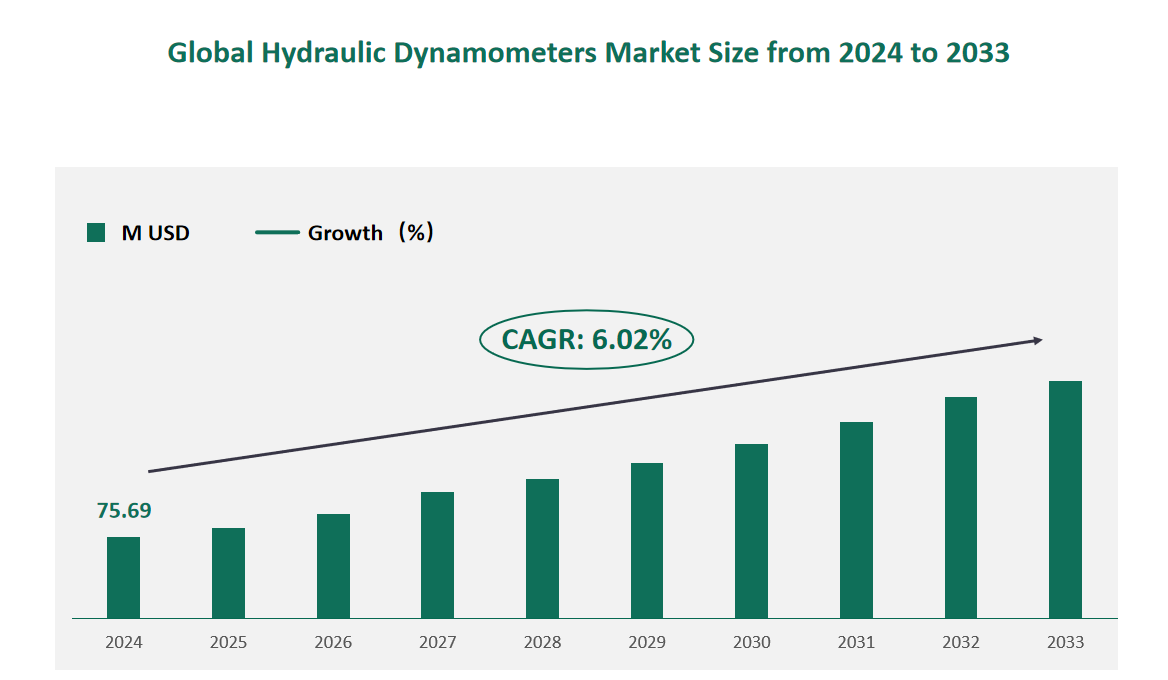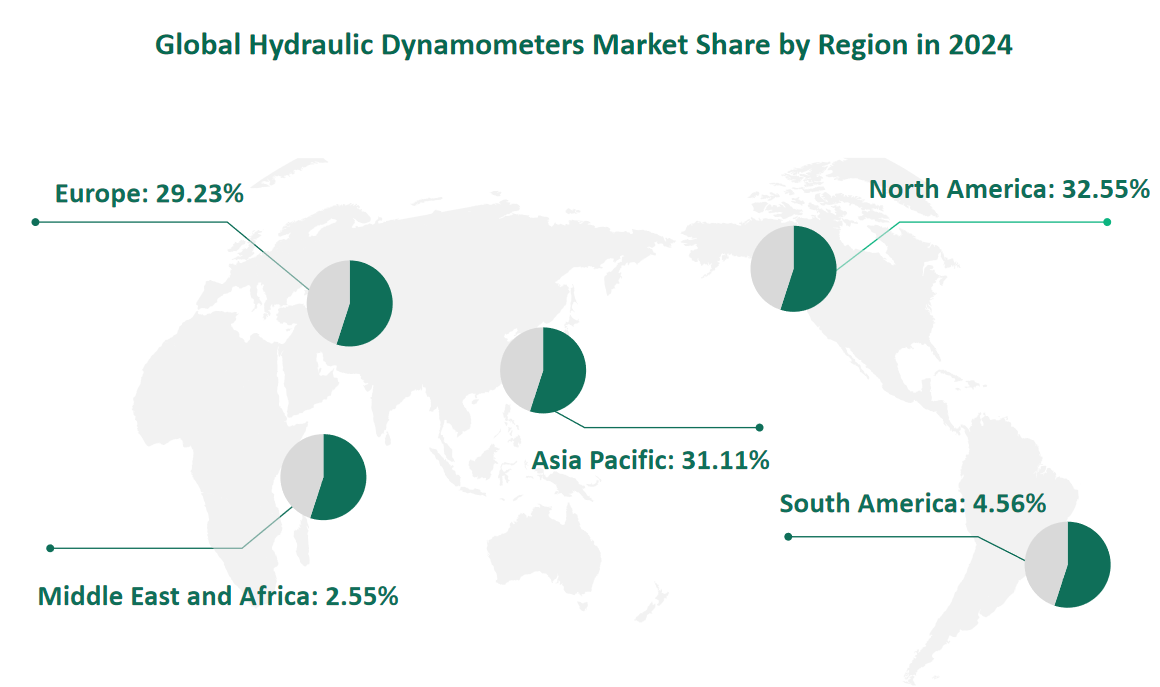1 Global Hydraulic Dynamometers Market Size (Value) and CAGR (2024-2033)
In 2024, the global Hydraulic Dynamometers market was valued at USD 75.69 million, with a CAGR of 6.02% from 2024 to 2033.
Hydraulic dynamometers are used to measure the force, torque, and power produced by different types of engines, motors, and other varieties of rotating movers.
Hydraulic dynamometer work compartment consists of blades and stainless steel rotors and stators.
A dynamometer measures power based on the speed rotation of disks and shafts inside of a casing. To cause rotation, liquid flows into hollow grooves that exist between the shafts and disks. The liquid rotates in a spiral motion, causing the unit to push against the outer casing. Applied brakes prevent the casing from moving, which is how the pressure is gauged. Their rotational speed is then measured to give a power output reading. The speed and force with which the shafts and disks turn will vary depending on the amount of pressure applied to them by the movement of liquid.
Figure Global Hydraulic Dynamometers Market Size (M USD) and CAGR 2024-2033

2 Hydraulic Dynamometers Market Drivers
Industrial Development and Technological Advancements
The global industrialization process has accelerated significantly in recent years, driving the continuous updating and upgrading of power systems in various industrial fields. Hydraulic dynamometers are essential tools for testing powertrains, ensuring that engines and motors meet the required performance, quality, and safety standards. The development of new energy vehicles, for example, has created a surge in demand for high-precision testing equipment. These vehicles require rigorous testing to validate their performance, efficiency, and emissions, making hydraulic dynamometers indispensable in the research and development phase as well as in production and quality assurance.
Stringent Regulations and Environmental Concerns
Governments around the world are implementing stricter regulations on vehicle emissions and noise pollution. This has led to the development of new fields such as NVH (Noise, Vibration, and Harshness) testing, where hydraulic dynamometers play a crucial role. The automotive industry, in particular, is under significant pressure to meet these regulatory standards, driving the demand for advanced testing solutions.
Economic Growth and Emerging Markets
Economic growth in emerging markets such as Asia-Pacific, Latin America, and the Middle East is another significant driver. These regions are experiencing rapid industrialization and urbanization, leading to increased demand for effective mobility solutions. The automotive industry in these regions is expanding, with countries like China and India becoming major players in vehicle manufacturing. This growth is driving the demand for hydraulic dynamometers, as manufacturers seek to ensure the quality and performance of their products.
3 Hydraulic Dynamometers Market Restraints
Existence of Alternative Technologies
One of the primary challenges is the presence of alternative testing technologies in the market. Eddy Current Dynamometers and AC Dynamometers, for example, offer certain advantages over hydraulic dynamometers. These alternatives are known for their durability, higher speed, tighter control, and faster response times. This competition poses a threat to the hydraulic dynamometer market, as some industries may prefer these alternative solutions for their specific testing needs.
Fluctuating Raw Material Costs
The production of hydraulic dynamometers relies on various raw materials, including stainless steel and electronic components. Fluctuations in the prices of these materials can significantly impact the manufacturing costs and profitability of the industry.
4 Global Hydraulic Dynamometers Market Size by Type in 2024
One-way rotation hydraulic dynamometers are the most commonly used type, designed primarily for testing engines and motors that operate in a single direction. These dynamometers are optimized for different speeds and provide high torque efficiency in their specified direction. In 2024, the one-way rotation segment is projected to account for the majority of the market, valued at 62.71 million USD. This dominance is attributed to their widespread use in automotive and industrial applications where unidirectional testing is sufficient.
Two-way rotation hydraulic dynamometers offer the flexibility of testing in both clockwise and counterclockwise directions. This feature is particularly useful in applications requiring bidirectional testing, such as certain types of turbines and specialized engines. In 2024, the two-way rotation segment is expected to be valued at 12.98 million USD. Although this segment is smaller, it is growing due to increasing demand from industries that require comprehensive testing capabilities.
Table Global Hydraulic Dynamometers Market Size by Type in 2024
Type | Market Size (M USD) 2024 |
One-way Rotation | 62.71 |
Two-way Rotation | 12.98 |
5 Global Hydraulic Dynamometers Market Size by Application in 2024
The automotive industry is the largest application segment for hydraulic dynamometers, driven by the need for rigorous testing of engines and powertrains. In 2024, the automotive segment is projected to be valued at 31.96 million USD. This segment includes both traditional internal combustion engines and the growing field of electric vehicles. The increasing demand for high-performance and environmentally friendly vehicles has led to stricter emissions standards and the need for advanced testing equipment. Hydraulic dynamometers play a crucial role in ensuring that automotive engines meet these standards, making this segment a significant driver of market growth.
The aircraft industry also relies heavily on hydraulic dynamometers for testing engines and turbines. In 2024, the aircraft segment is expected to be valued at 11.18 million USD. Aircraft engines require high precision and reliability, and hydraulic dynamometers provide the necessary testing capabilities to ensure these standards are met. The growth in the aerospace sector, driven by increased air travel and the development of new aircraft technologies, continues to drive demand for hydraulic dynamometers in this segment.
The shipbuilding industry is another significant application area for hydraulic dynamometers. In 2024, the ship segment is projected to be valued at 15.54 million USD. Ships require powerful and efficient engines to operate effectively, and hydraulic dynamometers are essential for testing these engines. The growth in global trade and maritime activities has led to increased demand for shipbuilding and, consequently, for testing equipment.
Table Global Hydraulic Dynamometers Market Size by Application in 2024
Application | Market Size (M USD) 2024 |
Automotive | 31.96 |
Aircraft | 11.18 |
Ship | 15.54 |
Others | 17.01 |
6 Global Hydraulic Dynamometers Market Size by Region in 2024
North America has historically been a significant market for hydraulic dynamometers, driven by the established automotive and aerospace industries in the United States and Canada. In 2024, the North American market is projected to be valued at 24.64 million USD. The region’s strong industrial base and technological advancements continue to drive demand for high-precision testing equipment. Additionally, stringent emissions regulations in the United States further necessitate the use of hydraulic dynamometers for compliance testing.
Europe is another key region for the hydraulic dynamometers market, with a projected value of 22.12 million USD in 2024. The region’s automotive and aerospace industries, particularly in Germany, France, and the United Kingdom, drive significant demand. European manufacturers are known for their high-quality engineering and precision manufacturing, making hydraulic dynamometers essential tools for product development and quality assurance. The push for greener technologies and stricter environmental regulations also contribute to the market growth in this region.
The Asia-Pacific region is emerging as a significant growth area for hydraulic dynamometers, with a projected market value of 23.54 million USD in 2024. Countries like China, Japan, and South Korea are experiencing rapid industrialization and urbanization, leading to increased demand for effective mobility solutions. The automotive industry in these countries is expanding rapidly, driving the need for advanced testing equipment. Additionally, the region’s shipbuilding industry, particularly in China and South Korea, further contributes to the market growth. The Asia-Pacific region is expected to see significant growth due to its expanding industrial base and increasing focus on technological innovation.
Figure Global Hydraulic Dynamometers Market Size by Region in 2024

7 Major Players in Global Hydraulic Dynamometers Market
7.1 HORIBA
Company Profile:
HORIBA, Ltd. is a Japanese multinational company founded in 1953, with its headquarters in Kyoto, Japan. The company is renowned for its wide range of analytical and measurement instruments, including automotive emission measurement systems, environmental monitoring equipment, and scientific analyzers. HORIBA’s manufacturing bases are primarily located in Europe, and it operates globally, serving clients in various industries.
Business Overview:
HORIBA’s business portfolio extends across multiple sectors, including automotive, environmental, medical, and semiconductor industries. The company is particularly well-known for its high-quality hydraulic dynamometers, which are used for testing engines and powertrains. HORIBA’s products are designed to meet stringent regulatory standards and provide precise measurement capabilities, making them essential tools for automotive manufacturers and research institutions.
Product Offered:
HORIBA offers a variety of hydraulic dynamometers, including the DT Dyno series. These dynamometers are known for their robust construction, compact design, and low maintenance costs. They are available in different power ranges and can be configured for one-way or two-way rotation, making them suitable for a wide range of applications, from passenger car engines to large industrial turbines.
Recent Financial Performance:
In the most recent fiscal year, HORIBA reported a revenue of 10.90 million USD from its hydraulic dynamometers business.
7.2 AVL List
Company Profile:
AVL List GmbH is an Austrian company founded in 1948, with its headquarters in Graz, Austria. AVL is a leading developer of powertrain and testing systems, providing solutions for hybrid systems, combustion engines, transmission systems, electric drives, and batteries. The company’s manufacturing bases are primarily located in Europe, and it operates globally, serving clients in the automotive and aerospace industries.
Business Overview:
AVL List is renowned for its comprehensive range of testing systems and simulation software, which are used by automotive and aerospace manufacturers worldwide. The company’s products are designed to meet the highest standards of precision and reliability, ensuring that engines and powertrains perform optimally and comply with environmental regulations. AVL’s commitment to innovation and quality has made it a trusted partner for many leading vehicle manufacturers.
Product Offered:
AVL offers the Omega Hydraulic Engine Dynamometer, which is designed for steady-state testing of combustion engines with power ranges from 550 kW to 12,000 kW. The AVL Omega Dyno operates on the Föttinger principle, converting absorbed energy into heat that is carried away by cooling water. This dynamometer is known for its high power-to-mass ratio, precise speed and torque measurement, and stable operation.
Recent Financial Performance:
In the most recent fiscal year, AVL List reported a revenue of 10.42 million USD from its hydraulic dynamometers business.
7.3 Power Test
Company Profile:
Power Test, LLC is an American company founded in 1976, with its headquarters in Waukesha, Wisconsin. The company is a leading designer, manufacturer, and seller of dynamometers, heavy equipment testing systems, and related data acquisition and control systems. Power Test’s manufacturing bases are primarily located in North America, and it operates globally, serving clients in various industries.
Business Overview:
Power Test is known for its innovative and reliable testing solutions, which are used by automotive, industrial, and aerospace manufacturers worldwide. The company’s products are designed to provide accurate and efficient testing capabilities, ensuring that engines and powertrains meet the highest standards of performance and safety. Power Test’s commitment to quality and customer service has made it a trusted partner for many leading manufacturers.
Product Offered:
Power Test offers the PTX Complete Engine Dyno System, which includes a 50X-Series complete water brake engine dynamometer. This system is designed for reliable engine certification testing in various applications, including on-highway, military, and construction vehicles. The PTX system is known for its long-term reliability, ease of use, and comprehensive data acquisition capabilities.
Recent Financial Performance:
In the most recent fiscal year, Power Test reported a revenue of 7.20 million USD from its hydraulic dynamometers business.

